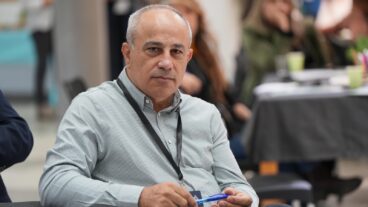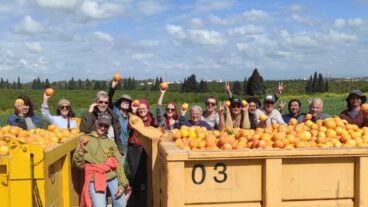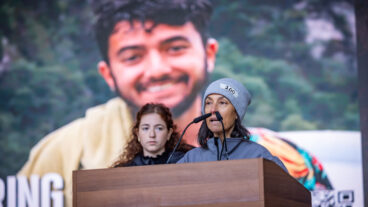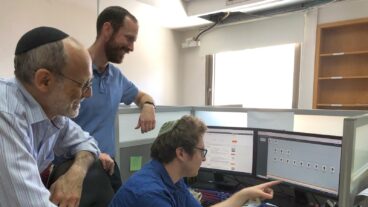This is a project that straddles both sides of the border – Nissim Almon, Sharon Drainage Authority. While the Green Line that divides Israel from the Palestinian Authority (PA) is closed and reopened according to changing security needs, the waters of the Alexander River flow through the demarcation line unfettered and undeterred.
Unfortunately, those waters have not always been as clean as Mother Nature intended. But for the past eight years Nissim Almon, Expert Manager of the Sharon Drainage Authority in the narrow middle region of Israel, has been doing something to redress the ravages industrial and agricultural waste inflicted on the precious waterway and its surrounding fragile ecosystems. In fact, Almon and his team have done such a good job that the Alexander River clean-up operation was recently awarded a prestigious Australian restoration award, the Thiess Riverprize, ahead of an impressive roster of big-budget green projects in Europe, China, India and the United States.
The Sharon region is one of the most densely populated areas of Israel and, as such, presented Almon with a complicated logistic challenge. “This is the narrowest part of the country with a large number of sewage infrastructure facilities,” he told ISRAEL21c. “Other problems are caused by the relatively large population here. We have a lot of industrial and agricultural activity, and that brings its own environmental headaches.”
One of the victims of the logistical sewage conundrum has been the Alexander River, which starts out in the hills near Nablus in the Palestinian Authority and flows through the Sharon region and into the Mediterranean Sea. Almon’s workload is exacerbated by the fact that much of the pollution that filters into the waterway comes from the Palestinian side of the Green Line.
“Over the years a lot of pollution entered the river from Netanya and kibbutzim and villages on the Israeli side, but that has mostly stopped now,” continues Almon. “But Taibeh (a town in the PA) still doesn’t have a central sewage system and some of their sewage goes into the river.”
Then there are leather-making factories and tahini (sesame) production facilities in the Palestinian cities of Nablus and Tul-Karem, oil-producing plants that pump large amounts of waste into the river, and other industrial plants that have sprung up in the PA in recent years and further pollute the Alexander River.
Considering the current political standstill between Israel and the PA, one would not hold out too much hope for any bilateral cooperation on the river pollution issue. However, happily, that is not the case.
“One of the most serious problems is that the Palestinians simply don’t have the room to create reservoirs for treatment of industrial and agricultural waste,” explains Almon. “We can solve part of that problem by setting up reservoirs for them on our side of the Green Line. This is a project that straddles both sides of the border.”
Today, around 93 percent of the sewage water in the Alexander River basin is treated, and over 20 million cubic meters of water a year are purified – through filtering and oxidization – and recycled for irrigational purposes.
The project constitutes a reciprocal solution. “The Palestinians don’t really have a need for the wastewater we get from the treatment process,” Almon continues. “Their traditional method of agriculture – the types of produce they grow and the small size of their agricultural plots – can’t use wastewater for irrigation. We can use it on our side and pass the treated water back to them. It is a wonderful plan involving cooperation between us and the Palestinians.”
In fact, there is a third partner here. The German government has been investing in the scheme and is committed to fund the creation of the reservoirs and treatment plants. It is an example of environmental interests transcending the Green Line. Adjustments have been made to allow more room for oxidization pools to be built on the Palestinian side.
Around 5 million cubic meters of sewage from Nablus and Tulkarm crosses the Green Line every year.
“We are talking about mostly untreated sewage. The German government is expected to complete a series of oxidization treatment pools near Nablus by the end of 2005.” But that figure is only the tip of the iceberg. “That represents only about 15 percent of the sewage that comes out of Nablus and Tulkarm,” Almon explains. “The other 85 percent seeps into the mountain aquifer which is one of the largest aquifers that provides both the Israelis and the Palestinians with water. We’ll have to address that problem too.”
Once in place, the treatment pools will allow Almon and his colleagues to further enhance the quality of the water of the Alexander River. Meanwhile, since he took up his post at the Sharon Drainage Authority, Almon has invested significant resources in an effort to eradicate pollution from the river and restore the vicinity of the river to its former green glory. He has achieved some impressive results.
Facing a desperate ecological predicament, Almon came up with what he calls his ‘river interface’ idea. “I realized we could do a lot to improve the quality of the water in the river without investing large amounts of money.”
All it needed, says Almon, is a change of mindset. “We could allow surplus sewage to flow into the river during the winter months, when the pollutants would be diluted and broken down by the large volume of water in the river. During the other nine months of the year we could, through biological and mechanical means, bring the river to a state whereby it would not have a bad odor and the water would take on a more natural color.”
When Almon started work on the Alexander basin, in some places the riverbanks had collapsed and left unsightly gashes with bare rock protruding where flora had once flourished. That damage has since been repaired and indigenous vegetation has been planted. Parks, picnic spots and trails have sprouted up on both sides of the waterway and the area attracts large numbers of nature lovers on weekends.
While the Alexander River project is still very much a work-in-progress, and there is clearly some way to go before all local pollution problems have been solved, significant gains have been, and continue to be, made across the border. “I believe that nature is capable of rehabilitating itself if you leave it to its own resources,” says Almon. “You just have to stop the contaminants from getting into the river and nature will do the rest. We’re working on that.”












